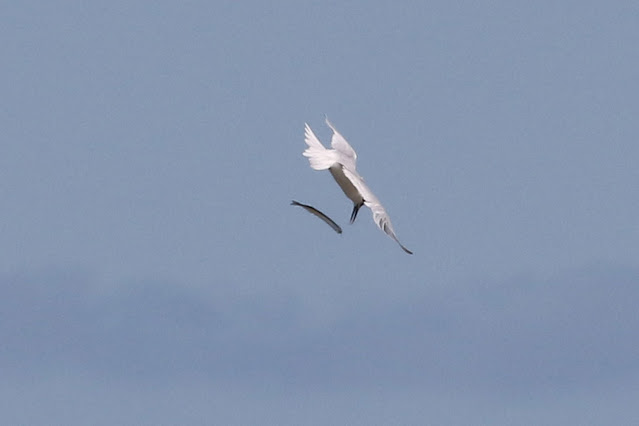Just outside the front door of the house were using during our stay were a couple of large lavender bushes which were like cat nip to the bees and butterflies. At any one time there were up to six Small Whites and three Large White and the bees and butterflies would fly up as you walked past.
On this Saturday morning though, the whites were joined by a Small Copper, that once it was able to avoid the bees settled and showed very well on the flower spikes.
We turned up at Minsmere around mid morning. I expected it to be busy but there were plenty of spaces in the car park. From the visitor centre we headed out to the north wall. The striking thing was just how dry everywhere looked. This is the field into which you can scan for the Stone Curlews in spring. Today it looked more like the African savannah, grazing zebra and few giraffes would not have been out of place.
As we walked across the north wall there was little noise or activity in the reed beds. The one highlight was a pair of Barnacle Geese that flew over heading towards Dunwich.
It was a beautiful day with plenty of wispy clouds to accentuate the blue sky, here looking south along the beach.
Here looking west from the dunes over the Scrape, to the left, north side baked mud, on the right south side water and mud.
Two waders flew in and stopped on one of the islands allowing identification as Greenshanks.
In the gorse were a family of Stonechats, these seemed to confuse a birder who pointed them out to me as Dartford Warblers.
From the sluice we walked out onto the beach. It was time for some black and white images, the deep blue sky and the clouds providing the perfect dramatic land scape
With the winds coming from the north east the sea was a little unruly, with surf crashing on to the beach.
The light house at the top of the picture is at Southwold.
The clouds from the the dunes.
Wispy Mare's tails. They are formerly known as cirrus uncinus clouds and occur at very high altitudes and usually signal that a warm front is approaching, bringing with precipitation (this is indeed what happened that evening but in a very small amount.)
There was some activity on the dunes with a pair of Reed Bunting raising the pulse a little feeding at the base of the dunes, while off shore a few Sandwich Tern passed. This individual was chased by a Black-headed Gull and eventually gave up its catch of a quite large fish.
A welcome surprise was a Gannet heading south quite close in.
And a Sanderling flew along the beach just above the tide line. Not the best Sanderling photograph I have ever taken but I was in need of some bird images.
In the dunes there were plenty of Grayling butterflies. The cryptic colouring provides the Grayling with excellent
camouflage, making it difficult to see when at rest on bare ground, tree
trunks, or stones. The wings are kept closed when not in flight and the
forewings are usually tucked behind the hind wings, concealing the eyespots and
making the butterfly appear smaller. In flight this is a distinctive, large
butterfly with a looping and gliding flight, during which the paler bands on
the upper wings are visible.
Walking back through the reserve ahead of us was Dunwich Heath, at this time of year the heath is a picture with the heather all in bloom. Even at the distance we were this could clearly be seen.
The time of year and weather conditions are not ideal for visiting Minsmere. However it was good to walk around the reserve and admire the beauty created by the time of year and exceptional dry weather that has transformed a lot of the reserve. We will be back at the end of September





















No comments:
Post a Comment